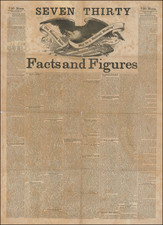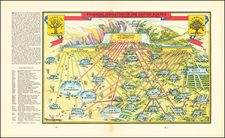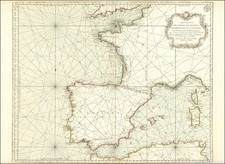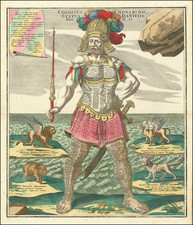"Hondius has given us many ships, but this is his finest." - Society for Nautical Research
A handsome early-17th-century ship portrait by Henricus Hondius, ostensibly showing a French Royal Navy vessel built in Holland in 1626.
The engraving shows a three-masted man of war, sails filled, and guns bristling from all sides. Fleurs-de-lis and crowned-Ls decorate the large flags topping the ship's masts.
The portrait proclaims itself to be a French naval vessel built in Holland in 1626. However, this does not square with what we know about French vessels built during that era. Some have said that the ship is actually the Courrone, the first of a series of ships ordered by Richelieu, which fundamentally changed the French navy in the middle of the 17th century. This is probably incorrect, as the Courrone was not built in Holland but rather France and not in 1626 but in 1636.
The Hondius image appears to be a close copy of a Claes Janszoon Visscher engraving of a Dutch three-masted vessel, thought to have been produced in 1625, the year before the present image. This might be the real identity of the present vessel: it is an image of a Dutch ship, which for unknown reasons, was re-engraved with attribution to the French navy.
The engraving's close association with at least two other ship portraits by Jacob Savery II (1592-1651) is worthy of further examination. The Navire Royale engraving faces a Savery engraving of a smaller vessel in this 17th-century French manuscript "Ordonnances et costumes de la mer." And this Savery ship portrait also bears a strong stylistic resemblance to the present work.
Identity of the Vessel
There is a disquisition on the use and misuse of the engraving in Volume II of the Society for Nautical Research's The Mariner's Mirror (1912), pages 189-190:
54. A DOUBTFUL SHIP-PORTRAIT. The original, after which Fournier had a smaller and clumsy copy made for his Hydrographie, is the fine print entitled "Navire Royale faicte en Hollande, Anno 1626," and published "A Amsterdam chez Henry Hondius." Hondius has given us many ships, but this is his finest. (This is reproduced in "The Rudder" for Sept., 1909, p. 192).
This may prove to represent the Saint Louis, of 1627. especially if there should be evidence that that ship was built in Holland; but she cannot possibly be the Couronne, which was built in Brittany, about ten years later than the date of the print. (Jal. Gloss. Naut. art. vaisseau). The Couronne, too, had Hercules and the Hydra as her figurehead, and was of seventy-two guns, while this "Navire Royale" has Jupiter with his bolts bestriding an eagle on her beak-head, and could hardly have had above sixty guns. The Foudroyant, of 1694, had Jupiter as her figure-head; possibly this is an earlier vessel of the name. A Royalle, of sixty guns, was in the French navy in 1671 (Dassié l'Architecture Navale) but navire royale I should take to be the equivalent of our "ship royal" rather than the actual name of the ship.
That this print was considered as an authority we have other evidence than Fournier's use of it, for "The first Dreadnought, launched 1573." as Mr. Fraser styles her in his "Champions of the Fleet," is taken from a print, with Hollar's mannerisms, where an unconvincing hull of about 1655 or so is shown with rigging copied from this "Navire Royale." Perhaps the London of Mr. Fraser is another borrowed ship of Hollar's, and more directly copied from the original.
The print, as used by Fournier, and reproduced in the catalogue of the Musée de Marine at the Louvre, was the base for Admiral Paris's reconstruction of the Couronne, now exhibited there. This, as might be imagined, is not a successful representation of the Couronne, or, indeed, of any ship of any time; it is one of the few failures, amongst many successes, of a worker to whom we as a society owe only less than to his great compatriot, Jal. -- R. M. N.
This print seems "to have played many parts." In "L'Armée and Marine," 21st June, 1903, it appears as a half-tone reproduction of a print in the Bibliothèque Nationale, and is stated to be the Couronne, built in 1661. How Mr. Fraser can call it the London I cannot imagine (unless she was captured and re-named), as she is covered with Fleurs-de-lis. But I have a book, entitled " Deutsches See Kriegs Geschichte," in which she parades as "De Ruyter's Flagship Lamm," with suitable alterations in the flags. But this last-mentioned book is full of errors-I am afraid in many cases intentional ones -since its object is to provide a suitable history and ancestry for the German Navy, in pursuance of which it endeavours to claim an hereditary share in the victories of the Dutch in their 17th century wars with this country. Other rather unaccountable errors are a print of a" galleasse " from Furtenbach, which is described as a "Dutch East Indiaman,' a print after Breugel which represents a Dutch ship, but which is here termed a "Hanseatic Fredekogge' (1560)," and the ship and row-barge from the picture in Froissart (Harl: M.S. 4,379), represent ing the Expedition of the Knights of France and England to Africa in 1390, which masquerade as "Ships of William the Conqueror."-C.F.
Editions and States
The Hondius engraving was reissued by Pieter Goos. In that later state, the copper plate has been trimmed or masked down.
As noted in The Mariner's Mirror, the image was reengraved for the frontispiece of Fournier's Hydrographie.
Henricus Hondius (1597-1651) was a Dutch engraver and mapmaker, a member of a prominent cartographic family. His father, Jodocus Hondius, was also an engraver and geographer. While working with his father, Henricus was instrumental in the expansion and republishing of Mercator’s atlas, first published in 1595 and republished by Hondius in 1606.
Upon his father’s death in 1612, Henricus and his brother, Jodocus the Younger, took over the business. He set up his own shop in 1621, where he continued to release new editions of the Mercator atlas. Later, he partnered with his brother-in-law, Jan Janssonius, in continuing to expand and publish Mercator’s atlas, which would become known as the Mercator-Hondius-Janssonius atlas. Born and based in Amsterdam, he died there in 1651.










![(California Pictorial Lettersheet) [Manuscript letter on Lettersheet with Bird's-eye view of Stockton, California]](https://storage.googleapis.com/raremaps/img/small/97542.jpg)



![[ Descendants of Noah ] Table historique du second age du monde tiree de la Genese...](https://storage.googleapis.com/raremaps/img/small/82009.jpg)